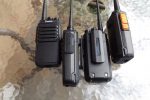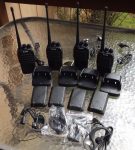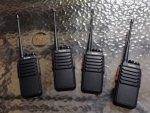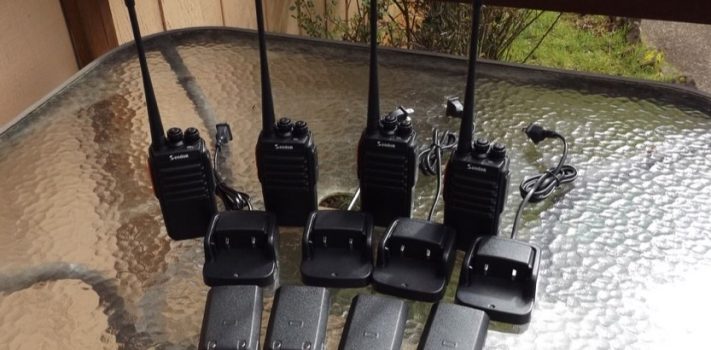Ever since I was a little kid, and built my first walkie-talkie (CB radio) – and the darn thing actually worked – I’ve been fascinated with radio communications with other folks. Of course, CB radios, are mostly a thing of the past now – everyone has a cell phone – but a good two-way radio certainly has its place for Preppers.
I spent considerable time searching for what I hoped would be an economical set of fairly reliable compact two-way radios, that would serve my purposes, during a SHTF scenario. Of course, price is always a consideration for me. We aren’t rich – not even close. We usually live paycheck-to-paycheck so we have to spend our funds wisely.
I found these radios on Amazon.com and ordered up four of them. You can get a two-pack, a 4-pack, or even a 5 or 8 pack. The 4 pack was under $60 and what came with this set-up was everything I wanted, and more. Initially, I was going to order a 2-pack. But for just a little bit more money, I went with the 4-pack. When the SHTF – and it will – I wanted to be able to stay in contact with at least one other person, who might join us on our small rural retreat, it’s not big, just about 3.5-acres. In the event, that we needed to patrol this small patch of land, it was important that I stay in contact with another person, who might be working with me on a patrol. Our little retreat is heavily wooded, and you can’t always see another person who might only be 50-feet from you. Now, with four radios, we can stay in touch while outside, as well as with people inside the house.
When it comes to two-way radios, I’m certainly no expert, I just know what works and what doesn’t work, so I took a chance on these Seodon two-way FM radios. These are not the typical “bubble pack” single-channel or dual-channel Family Radio Service (FRS) walkie-talkies that you often find sold in sporting goods stores. These have 15 channels. Note that these radios are made in mainland China. So if that is a deal-breaker for you, then read no further.
I’m sure many readers will remember the old commercial for T-Mobile cell phones, where the gent in the commercial can be heard asking: “Can you hear me now? Well, all I needed was some basic radios — so that I could communicate with other people, without having to repeat: “Can you hear me now?”
 These Seodon two-way FRS radios filled my needs. We don’t plan on going out far from our retreat, that would be foolish, during a SHTF scenario. However, I wanted to be able to clearly communicate with others in and around our digs, at a reasonable cost. These Seodon radios fit the bill perfectly. As already mentioned, price was a big factor in searching for good radios, and these radios are about as inexpensive as any that I’ve found — far less expensive than many others.
These Seodon two-way FRS radios filled my needs. We don’t plan on going out far from our retreat, that would be foolish, during a SHTF scenario. However, I wanted to be able to clearly communicate with others in and around our digs, at a reasonable cost. These Seodon radios fit the bill perfectly. As already mentioned, price was a big factor in searching for good radios, and these radios are about as inexpensive as any that I’ve found — far less expensive than many others.
As mentioned, I’m no expert in this field, and I don’t pretend to be one. I’ll give some info on these radios as best I can. However, you can find a wealth of information on their website – probably more info than you’ll need. This is a 4-pack of radios, and each radio comes with two batteries, as well as an earbud for more quiet communications. You really don’t want your radio going off with the nmain speaker, alerting someone to your position – hidden or not.
 It’s hard to pinpoint how long a radio’s battery will last, without having to recharge or swap out batteries. So, an extra battery with each radio was most welcomed. If you don’t use the radio much, then you can expect 5-to-7 days of stand-by time – if the radio is left on. But if you use the radio for a lot of talk, then you can expect an 8-to-12 hour of use. For typical use, expect to get about 1-to-2 days of useful talk time, before you’ll have to swap out batteries.
It’s hard to pinpoint how long a radio’s battery will last, without having to recharge or swap out batteries. So, an extra battery with each radio was most welcomed. If you don’t use the radio much, then you can expect 5-to-7 days of stand-by time – if the radio is left on. But if you use the radio for a lot of talk, then you can expect an 8-to-12 hour of use. For typical use, expect to get about 1-to-2 days of useful talk time, before you’ll have to swap out batteries.
As an experiment, I allowed the batteries to go completely dead, and then recharged the batteries. It varied on how long it took to recharge some of the batteries, some took a couple hours – some longer. The spare, fully-charged battery is an added bonus if you ask me. I checked around, and spare batteries are running about $10 each. So, you see, this package deal is really a great deal if you ask me. There are two chargers with two-pack of radios. So, you can charge two batteries at a time, or four batteries if you have four radios.
A word on charging the batteries: You can charge the batteries separately from the radio. However, you really have to get the batteries just perfectly positioned in the chargers or they won’t charge – be advised. It’s easier to charge batteries when they are attached to a radio. There is also a USB port on the radio, if you need to charge a radio that way – as if you were in your car, you can charge a battery that way.
 Each radio comes with a belt clip, as well as a wrist strap – nice! There is a “rubber ducky” type antenna that is easily screwed on the radio. You can also add other antennas that will give you longer-distance, if needed. Speaking of which, it is next to impossible to determine how far out these radios will reach. The web site says they have a range of about 5-miles – of course, this depends on the terrain. Out on a plain, you can indeed talk to someone at least 5-miles away. But in a big city, maybe it will only work for a mile or two. And out in the boonies, where we live, there are a lot of trees and mountains. So it’s hard to say how far you can reach out and talk to someone – be advised! I drove up a small mountain near my house to provide line of sight, and it’s a 5-mile drive. From there, I could talk with my wife on her radio without any problems.
Each radio comes with a belt clip, as well as a wrist strap – nice! There is a “rubber ducky” type antenna that is easily screwed on the radio. You can also add other antennas that will give you longer-distance, if needed. Speaking of which, it is next to impossible to determine how far out these radios will reach. The web site says they have a range of about 5-miles – of course, this depends on the terrain. Out on a plain, you can indeed talk to someone at least 5-miles away. But in a big city, maybe it will only work for a mile or two. And out in the boonies, where we live, there are a lot of trees and mountains. So it’s hard to say how far you can reach out and talk to someone – be advised! I drove up a small mountain near my house to provide line of sight, and it’s a 5-mile drive. From there, I could talk with my wife on her radio without any problems.
Speaking of the earbud, it comes with an earpiece, that allows you to place the earbud in your ear, and then it loops around the outside of your ear – no worries about it falling out of your ear. Simply plug this earbud into the radio, and you are good to go – just press on the earbud (button) to talk to another person. Fairly covert operation.
 Each radio comes with a user’s manual, and it is clearly written, so anyone can understand how to operate these radios. You don’t have to be a genius to get these radios going right out of the box. This model has 15 channels you can pick from to use, and it is easy to do. Once you turn a radio on, a synthesized voice speaks to you, and tells you what channel the radio is on. To change channels, you simply turn the frequency dial to go to another channel. You can program other channels – see their web site for more details on this. There is also a belt/clothing clip you can easily attach to the back of each radio if you want to carry the radio on a belt or pocket.
Each radio comes with a user’s manual, and it is clearly written, so anyone can understand how to operate these radios. You don’t have to be a genius to get these radios going right out of the box. This model has 15 channels you can pick from to use, and it is easy to do. Once you turn a radio on, a synthesized voice speaks to you, and tells you what channel the radio is on. To change channels, you simply turn the frequency dial to go to another channel. You can program other channels – see their web site for more details on this. There is also a belt/clothing clip you can easily attach to the back of each radio if you want to carry the radio on a belt or pocket.
 These consumer-grade FRS radios are NOT waterproof – just like many of the others on the market. So, if you have to use one of the radios when its raining outside, that I would keep the radio in a plastic bag, in a pocket, or under a jacket – once again, be advised. There are other functions that would take too long to explain in detail in this article, so go to their website and read it for yourself.
These consumer-grade FRS radios are NOT waterproof – just like many of the others on the market. So, if you have to use one of the radios when its raining outside, that I would keep the radio in a plastic bag, in a pocket, or under a jacket – once again, be advised. There are other functions that would take too long to explain in detail in this article, so go to their website and read it for yourself.
My main goal was to get some easy-to-use two-way radios, that would allow me to stay in contact with another person – or more – when outside, keeping watch over our small homestead, in the event something bad happens and we are on our own, and need to fend for ourselves — or defend ourselves.
Before you lay down your hard-earned money, for any type of two-way radios, be sure to shop around, for the set-up you will find most useful. For us, this consumer-grade FRS set-up from Seodon was sufficient and will serve our needs without a great outlay of funds – which we don’t have.
Now, when it comes to an EMP attack: I would suggest keeping these radios in an EMP-protective Faraday bag – very easy to find inexpensively on the Internet. Keep the radios and everything that goes with them, inside of an EMP bag, and then after the EMP event you should still have two-way radios that work. To be sure, your cell phones won’t be working, nor will most other electronic devices that are either connected to the grid or that depend on grid power.
Many folks don’t stop and think about how they will communicate with one another – within a given distance – once the cell phones and land-line phones no longer work. A good two-way radio set-up is a low-cost investment in communications redundancy. So, start looking around for some two-way radios that will suit your needs. You’ll be glad you did.










